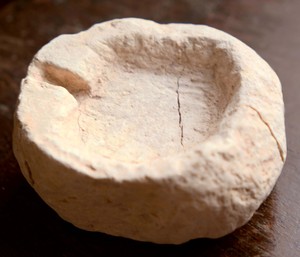Cypriot limestone small mortar: Neolithic or Chalcolithic
If this is probably a small, crude, mortar, it is almost impossible to date but very evocative. However I would have expected a smoother interior. I am unsure if it should be described as soft limestone or compact chalk. Households had much grinding equipment for different purposes but grinding stones (or pestles) are found in collections more often than mortars. It probably comes from a settlement as such things were not normally put in tombs (though in the neolithic I am less sure). If it is a mortar, this must have been for grinding small quantities of some flavouring or medicine or pigment. It was collected in Cyprus but this is a very obvious example of how meaning is lost from a lack of excavation context.
Except for the "spout", it looks very like a very early, Aceramic (pre-pottery) Neolithic bowl (9th-8th millenium BC) of similar diameter in the Cyprus Museum, though more shallow. If made later it was a poor and crude example. A harder stone would have been preferable for either purpose but more difficult to obtain than limestone.
Alternatively hollowed out stones were used as lamps well into the Bronze Age, though, again, the crudity suggests an earlier date. A wick made of plant fibre would have dipped into the oil or fat in the side channel. Presumably the stone would have absorbed some of the oil at first.
Crack opposite spout. (There was no information as to whether the shells it was sold with were excavated at the same time, but it seems possible so I have retained them).
Size: 4 x 9 x 8 cm
(Ex collection of David Read, acquired between 1966-1969 while working as a government official in Cyprus. He explored the ancient sites and museums and got to know local collectors and historians.)
(Aquired 14th Dec 2017 through Chiswick Auctions from failed lot 152 (part))
DJ96

